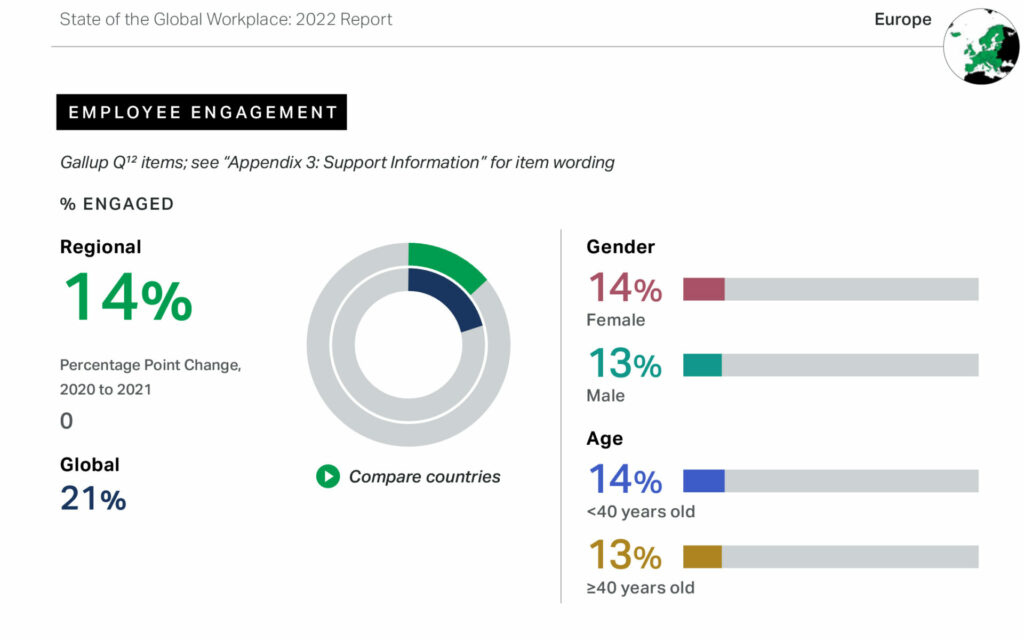How can you stay engaged when everything is changing within companies and it becomes very difficult to have a vision of the organisation’s strategy as it adapts to different contexts? Given the ever-greater uncertainty, ever-greater acceleration, etc., it’s not surprising that employees, and managers in particular, are becoming less and less committed.
Besides, there is a crisis of motivation to become a manager. Those who are managers get pulled in many directions between collective work, the ‘phygital’ and new expectations relating to data, AI and the whole business of remote working now.

Let us begin with a definition. There are three ways of defining involvement at work, with the terms ‘motivation’, ‘involvement’ and ‘engagement’:
– Motivation is when you enjoy doing something, be it for intrinsic reasons personal to you or extrinsic reasons that come from outside.
– Involvement is when you enjoy doing something and in addition, you get a result. There is, therefore, a positive deliverable.
– Engagement represents a higher level again. It is when you enjoy doing something and you obtain a result but above all, you carry others with you. This case embodies the idea of influence and dynamism. And this is what companies are seeking: committed employees, managers who have some influence, who are group dynamics ‘figureheads’.
The pandemic and the crises that we have been through have led to a fundamental change
So how can people remain engaged? It is very important to understand that the pandemic and the crises that we have been through have led to a fundamental change.
The first change is that previously, when we spoke of engagement we were engaged to a group. Today, we are engaged to a community.
Previously, we were engaged to the company’s brand, its products, the way our work was organised, to what we did. Today, above all with the arrival of the Alpha generation, we are engaged because we are part of a project that embodies a value, that embodies a mission, that is much bigger than the individual.
We are engaged because we like the people with whom we work, and we work in a community. We are engaged because we can learn, because we can develop skills. It is clear here that we are no longer engaged to the organisation but to what it provides us with at the individual level.
The expectations of employees who are engaged are no longer rational.
The second big change is the root of engagement. Before, we were engaged because we could have a career, because we were paid well, because we had a future… Today, all the studies, including the latest by Gallup in 2022, show that the expectations of employees who are engaged are no longer rational.
They are expectations related to the way in which we work: kindness, being listened to, the manner in which we are understood, the way in which trust is perceived. It is clear that today, engagement is expressed much more in terms of relationships whereas previously it was in terms of production.
Simple solutions
- Firstly, it is absolutely necessary to train employees and managers to have a vision of their own meaning at work. And that can be learned!
- Secondly, it is important to have a management system based on a methodology. To that end, we created the 5R® model that can be summarised like this: for a group to be engaged, each member must have a role, recognition, routine, rules and respect.
- Thirdly, it is important to have warning systems. These can take the form of questionnaires, but also “apps” to indicate when loss of engagement is starting to show up.
- To conclude, in order to develop engagement it is important to disseminate a new leadership method. We have identified two solutions for this: using mindfulness (which is truly a response to the acceleration within organisations) and managing through care, since knowing how to take care of yourself in order to better take care of your team is a very positive lever.
This is an adaptation of an article previously published in French by Xerfi Canal.
This post gives the views of its author, not the position of ESCP Business School.
License and Republishing
The Choice - Republishing rules
We publish under a Creative Commons license with the following characteristics Attribution/Sharealike.
- You may not make any changes to the articles published on our site, except for dates, locations (according to the news, if necessary), and your editorial policy. The content must be reproduced and represented by the licensee as published by The Choice, without any cuts, additions, insertions, reductions, alterations or any other modifications.If changes are planned in the text, they must be made in agreement with the author before publication.
- Please make sure to cite the authors of the articles, ideally at the beginning of your republication.
- It is mandatory to cite The Choice and include a link to its homepage or the URL of thearticle. Insertion of The Choice’s logo is highly recommended.
- The sale of our articles in a separate way, in their entirety or in extracts, is not allowed , but you can publish them on pages including advertisements.
- Please request permission before republishing any of the images or pictures contained in our articles. Some of them are not available for republishing without authorization and payment. Please check the terms available in the image caption. However, it is possible to remove images or pictures used by The Choice or replace them with your own.
- Systematic and/or complete republication of the articles and content available on The Choice is prohibited.
- Republishing The Choice articles on a site whose access is entirely available by payment or by subscription is prohibited.
- For websites where access to digital content is restricted by a paywall, republication of The Choice articles, in their entirety, must be on the open access portion of those sites.
- The Choice reserves the right to enter into separate written agreements for the republication of its articles, under the non-exclusive Creative Commons licenses and with the permission of the authors. Please contact The Choice if you are interested at contact@the-choice.org.
Individual cases
Extracts: It is recommended that after republishing the first few lines or a paragraph of an article, you indicate "The entire article is available on ESCP’s media, The Choice" with a link to the article.
Citations: Citations of articles written by authors from The Choice should include a link to the URL of the authors’ article.
Translations: Translations may be considered modifications under The Choice's Creative Commons license, therefore these are not permitted without the approval of the article's author.
Modifications: Modifications are not permitted under the Creative Commons license of The Choice. However, authors may be contacted for authorization, prior to any publication, where a modification is planned. Without express consent, The Choice is not bound by any changes made to its content when republished.
Authorized connections / copyright assignment forms: Their use is not necessary as long as the republishing rules of this article are respected.
Print: The Choice articles can be republished according to the rules mentioned above, without the need to include the view counter and links in a printed version.
If you choose this option, please send an image of the republished article to The Choice team so that the author can review it.
Podcasts and videos: Videos and podcasts whose copyrights belong to The Choice are also under a Creative Commons license. Therefore, the same republishing rules apply to them.





